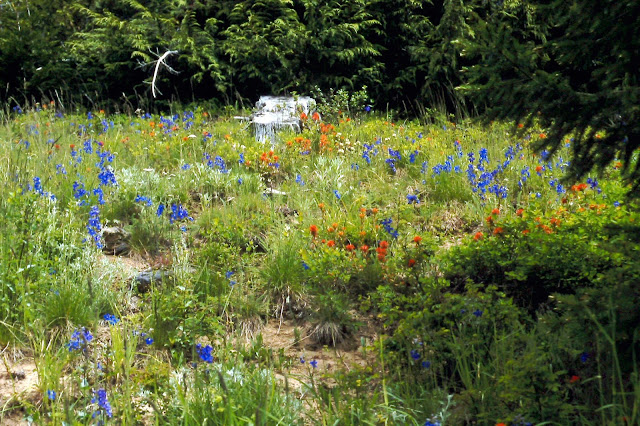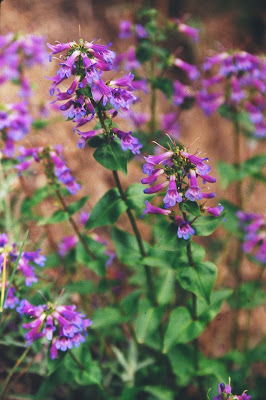 |
| As the access road winds its way up to Hurricane Ridge, one can glimpse Lilium columbianum in sunny clearings. |
reported on the specific place on Mt. Rainier that is called Paradise, and today I move across Puget Sound to the Greek version of plant heaven, Mt. Olympus. The easily accessible part of this paradise is called Hurricane Ridge. I know the name doesn't sound that heavenly, but in terms of wildflowers it definitely qualifies.
.
You would rightfully expect that many of the same wildflowers would be found in Olympic National Park as in Mt. Rainier National Park, but in my many visits, I've found some different gems, and some of the old favorites are worth repeating.
.
 |
| My old favorite, Aquilegia formosana, also graces clearings on the mountainside. |
.
.
.
.Even before arriving at Hurricane Ridge, flowers abound in roadside clearings and meadows, including columbia lilies, red columbines, and checkered lilies.
.
 |
| Fritillaria lanceolata, the checkered lily. |
.
Once at the Hurricane Ridge parking lot, spectacular views of the Olympic Mountains open up, and the lush flower garden of the alpine meadow lies before us.
.
 |
| Mt. Olympus and the other peaks of the central range lie directly across the valley from Hurricane Ridge. |
 |
| A young buck enjoys the meadow as well. |
 |
| Avalanche lilies, Erythronium montanum, dot the meadow soon after the snow melts. |
.
 |
| Avalanche lilies poke up through the prostrate branches of an alpine . |
 |
| Brilliant blue delphiniums and orange Indian paint brush (Castilleja sp.) splash across the meadow. |
.
 |
| Delphinum glareosum is common on Hurricane Ridge. |
 |
| A wild onion, probably Allium crenulatum can be found in Olympic meadows. |
 |
| Butter-and-eggs, Linaria vulgaris, is common throughout western mountains. |
 |
| The yellow Erysimum arenicola (Brassicaceae) pops up among heathers and other shrubs on the high mountain slopes. |
 |
| Douglasia laevigata (Primulaceae), the cliff dwarf primrose. |
 |
| Phlox diffusa (Polemoniaceae) |
 |
| Potentilla flabelliformis (Rosaceae) |
 |
| Rhododendron albiflorum (Ericaceae) |
 |
| Arenaria capillaris (Caryophyllaceae), the slender mountain sandwort |
 |
| Phacelia sericea (Hydrophyllaceae) |
 |
| Phyllodoce empetriformis (Ericaceae), an alpine heather. |
 |
| The marmot is another high mountain resident. |
 |
| The alpine fir, Abies lasiocarpa, is the main tree that survives the harsh conditions of Hurricane Ridge. |
 |
| Penstemon procerus (in the family formerly known as Scrophulariaceae) |
 |
| A rare sight is this colony of slime mold creeping across the forest floor. |
 |
| Campanula rotundifolia (Campanulaceae) |
 |
| Eriophyllum lanatum (Asteraceae) |
.
.
.
.
.
No comments:
Post a Comment
Note: Only a member of this blog may post a comment.